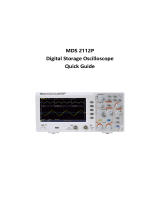Rising edge triggering
Falling edge triggering
The reading shows the trigger level value of the corresponding channel.
14. It indicates the measured type and value of the corresponding channel. "T"
means period, "F" means frequency, "V" means the average value, "Vp"
the peak-peak value, "Vr" the root-mean-square value, "Ma" the maximum
amplitude value, "Mi" the minimum amplitude value, "Vt" the Voltage value
of the waveform's flat top value, "Vb" the Voltage value of the waveform's
flat base, "Va" the amplitude value, "Os" the overshoot value, "Ps" the
Preshoot value, "RT" the rise time value, "FT" the fall time value, "PW" the
+width value, "NW" the -Width value, "+D" the +Duty value, "-D" the -Duty
value, "PD" the Delay A->B value, "ND" the Delay A->B value, "TR"
the Cycle RMS, "CR" the Cursor RMS, "WP" the Screen Duty, "RP" the
Phase, "+PC" the +Pulse count, "-PC" the - Pulse count, "+E" the Rise
edge count, "-E" the Fall edge count, "AR" the Area, "CA" the Cycle area.
15. The readings show the record length.
16. The frequency of the trigger signal.
17. The readings show current sample rate.
18. The readings indicate the corresponding Voltage Division and the Zero
Point positions of the channels. "BW" indicates bandwidth limit.
The icon shows the coupling mode of the channel.
"—" indicates direct current coupling
"~" indicates AC coupling
" " indicates GND coupling
19. The reading shows the setting of main time base.
20. It is cursor measure window, showing the absolute values and the
readings of the cursors.
21. The blue pointer shows the grounding datum point (zero point position) of
the waveform of the CH2 channel. If the pointer is not displayed, it means
that this channel is not opened.
22. The two blue dotted lines indicate the horizontal position of cursor
measurement.
23. The yellow pointer indicates the grounding datum point (zero point position)
of the waveform of the CH1 channel. If the pointer is not displayed, it
means that the channel is not opened.
How to Implement the General Inspection
After you get a new oscilloscope, it is recommended that you should make a
check on the instrument according to the following steps:
1. Check whether there is any damage caused by transportation.




















